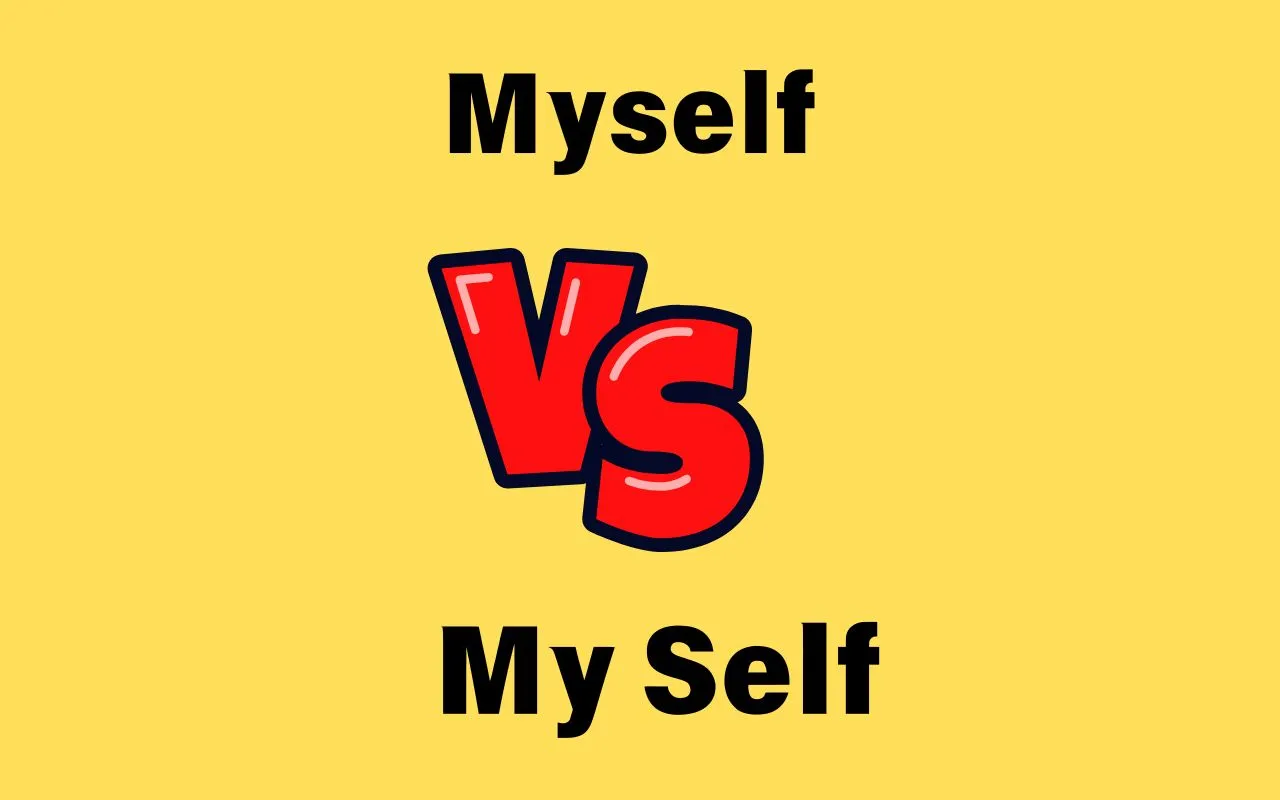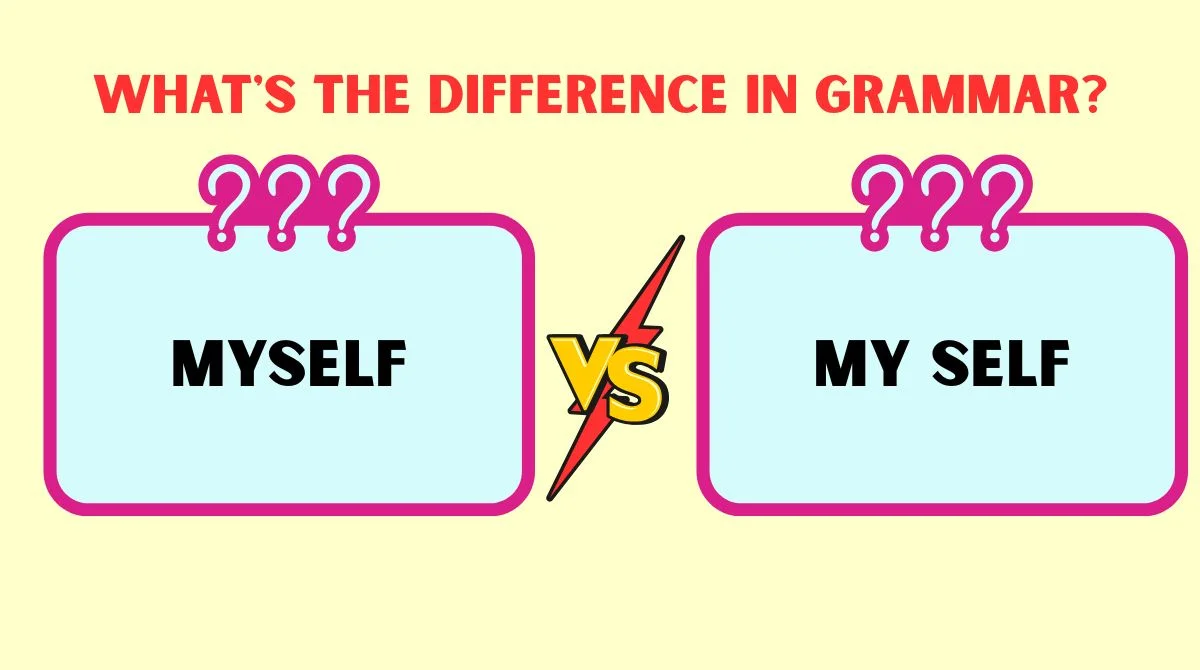Last updated on September 12th, 2025 at 04:23 pm
In the world of English grammar, myself and my self are often used interchangeably, but they have distinct meanings and purposes.
Understanding the difference between these two terms will not only enhance your writing but also sharpen your understanding of how pronouns work.
This article delves into the proper use of “myself” and “my self,” highlighting key distinctions and offering practical advice on when to use each one.
Exploring the Pronoun “Myself” in American English

At first glance, myself may seem like a simple word, but it holds more weight in grammar than many realize.
In American English, myself is a reflexive pronoun, a term that refers back to the subject of the sentence.
Reflexive pronouns are used when the subject and the object of the sentence are the same person or thing.
Defining Myself as a Reflexive Pronoun
A reflexive pronoun is used when the subject of the sentence performs an action on itself. Myself specifically refers to the first person singular.
For example:
- “I taught myself how to play the piano.”
In this case, the action (teaching) is performed by the subject (I) on itself (myself).
Reflexive pronouns are important for clarity in sentences, ensuring the subject and object are connected. They include myself, yourself, himself, herself, itself, ourselves, yourselves, and themselves.
Is it “myself” or “my self”? Learn the key differences between these terms, from reflexive pronouns to discussions on personal identity.
Examples of Using “Myself” in Sentences
Let’s break down how myself works in context with a few practical examples:
- “I hurt myself while jogging yesterday.”
- Here, the subject (I) performed the action (hurt) on itself.
- “I made the decision to go on vacation by myself.”
- In this case, the word myself emphasizes that the action was done alone.
- “I will take care of it myself.”
- Myself emphasizes personal responsibility for the task.
Each of these examples shows how myself links the subject to the object of the sentence.
The Nuanced Context of “My Self”
Now that we’ve examined the reflexive use of myself, let’s dive into the term my self. Unlike myself, my self is rarely used in standard English writing and has specific, more philosophical or introspective connotations.
When to Use “My Self”
My self is often used in discussions about one’s identity or self-awareness, focusing on the individual as a concept rather than a subject performing an action. For example:
- “I need to understand my self better before making any decisions.”
In this sentence, my self refers to the speaker’s broader sense of identity or existence, rather than an action being performed on the speaker.
This distinction highlights the philosophical angle of my self, which can be used when exploring concepts of self-awareness or personal growth.
“Myselves”: Addressing the Common Misconception
One of the most common errors people make with myself is attempting to use myselves in place of myself in the plural form. While it might sound natural to some, myselves is grammatically incorrect and never used in standard English.
Why “Myselves” Is Incorrect
Myself is a singular reflexive pronoun and has no plural counterpart. The correct plural form is ourselves when referring to the first person plural. For example:
- “We made the decision ourselves.”
Rather than using myselves, always opt for ourselves when referring to multiple people performing actions on themselves.
Historical Usage and Popularity: “Myself” in Literature
Myself has an interesting history in the English language, especially in literature. Historically, it has been used to emphasize personal involvement or action in a sentence, providing a deeper sense of individual control or responsibility.
“Myself” in Classical Literature
- Shakespeare, for instance, often used myself for dramatic emphasis in his plays.
- In works such as Hamlet or Macbeth, the use of reflexive pronouns like myself helped to build tension and underscore characters’ personal struggles.
Although the word myself has evolved, its use in literature set the stage for its more common use in modern grammar.
How “Myself” Functions Grammatically
Now that we’ve explored myself in its reflexive form, let’s break down its grammatical role in more detail. Reflexive pronouns serve not only to link the subject and object but also to emphasize the subject’s agency in performing an action.
When “Myself” Is Both the Subject and the Object
The most common grammatical structure with myself involves the subject and object being the same. For instance:
- “I made this decision by myself.”
In this sentence, the subject (I) is performing the action, and the object (myself) is the same person. This helps to emphasize the isolation or independence of the action.
The Role of “Myself” in Emphasizing Personal Action
While reflexive pronouns like myself are commonly used to indicate self-directed action, they also serve to emphasize the degree to which an action is personal.
Emphasis on Personal Responsibility or Action
For example:
- “I’ll handle it myself.”
Here, myself emphasizes that the speaker will take full responsibility for the task, leaving no room for others to interfere.
Using myself for emphasis adds weight to the action, signaling that it was done deliberately or with extra effort.
Conversing About Identity: The Non-Reflexive “My Self”
As mentioned earlier, my self is sometimes used to discuss personal identity in a broader, more introspective context. It’s not used for actions but rather for philosophical or psychological discussions of who we are.
Philosophical and Psychological References to “My Self”
- “I must align my self with my values if I am to succeed in life.”
Here, my self refers to the inner, personal self, emphasizing identity and personal growth.
This usage is more common in fields like psychology, philosophy, and self-help literature.
Common Mistakes and Tips to Remember the Difference

Understanding the distinctions between myself and my self isn’t always easy, but here are a few tips to avoid common mistakes:
- Don’t use myself as the subject of a sentence.
- Incorrect: Myself went to the store.
- Correct: I went to the store.
- Use myself only as a reflexive pronoun or for emphasis.
- Correct: I’ll do it myself.
- Reserve my self for philosophical contexts or when discussing identity.
- Correct: I’m trying to find my self through meditation.
FAQs
What is the difference between “myself” and “my self”?
“Myself” is a reflexive pronoun used for actions performed by the subject on themselves, while “my self” refers to personal identity or self-awareness in philosophical contexts.
When should I use “myself”?
Use “myself” when the subject performs an action on itself (e.g., “I taught myself”) or to emphasize personal responsibility (e.g., “I did it myself”).
When is it correct to use “my self”?
“My self” is used in philosophical or introspective contexts to discuss one’s sense of identity, as in “I need to understand my self better.”
Is “myself” ever incorrect?
Yes, “myself” should never be used as the subject of a sentence. For example, “Myself went to the store” is incorrect; use “I went to the store” instead.
Why is “myselves” incorrect?
“Myselves” is a common mistake. The plural form of “myself” is “ourselves,” not “myselves.”
How can I remember when to use “myself” and “my self”?
Think about the context: Use “myself” for reflexive actions or emphasis, and use “my self” for discussions about personal identity or growth.
Final Thoughts and Best Practices in Writing
In conclusion, while myself and my self may seem similar at first, understanding their unique roles can make your writing more precise and impactful.
Always remember that myself is a reflexive pronoun used for self-action and emphasis, while my self refers to identity and self-awareness.
By mastering these distinctions, you’ll elevate your communication skills and avoid common grammatical mistakes.
If you ever find yourself unsure, take a moment to consider the context—are you talking about an action, or are you reflecting on your personal identity? That simple step will help you choose the right form every time.
